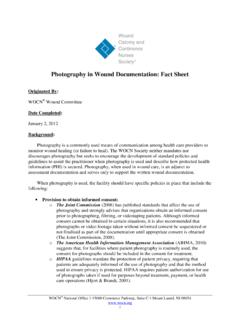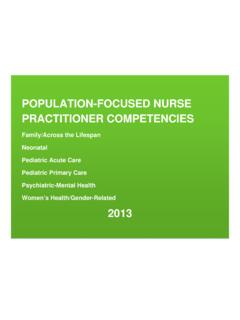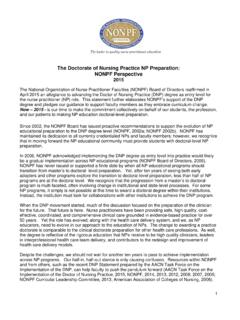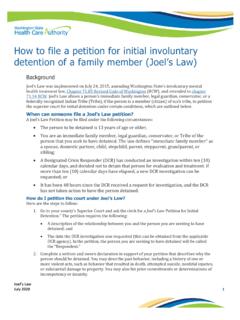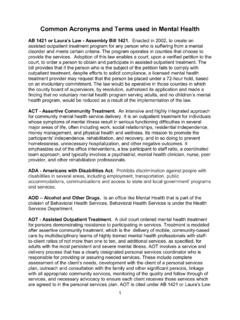Transcription of The Mental Health Procedures Act Demystifying the 302 …
1 10/15/2013 1 THE Mental Health Procedures ACT Demystifying THE 302 PROCESS Kelly M. Rock, DNP, CRNP Objectives Participants will identify basic understanding of content of the Mental Health Procedures Act Participants will identify criteria needed to pursue an involuntary commitment and step-by-step process they must take. Participants will voice understanding of the Tarasoff law, including duty to warn and duty to protect Background Mental Health / Mental Retardation Act of 1966 Establishes County MH/MR Board Requires County Administrator Appointment Requires provision of services for individuals with MH/MR needs State centers State hospitals Local systems Local systems required to provide: Short-term inpatient Outpatient Partial Hospitalization Emergency Services 24 hours/day Consultation and Education Aftercare services following release from state/county facilities Sheltered workshop Rehabilitative/training Unified intake Procedures Mental Health Procedures Act Enacted in 1976 Designed to assure adequate treatment for individuals with Mental illness Identifies exclusionary groups Provides for Voluntary (201) and Involuntary (302) treatment Provides for Inpatient and Outpatient treatment Provides rights to individuals subject to treatment Mental Health Procedures Act Adequate treatment : means a course of treatment designed and administered to alleviate a person s pain and distress, and to maximize the probability of his recovery from Mental It may include inpatient treatment , partial hospitalization, or outpatient treatment .
2 Adequate inpatient treatment shall include such accommodations, diet, heat, light, sanitary facilities, clothing, recreation, education and medical care as necessary to maintain decent, safe and healthful living conditions. treatment shall include diagnosis, evaluation, or rehabilitation needed to alleviate pain and distress, and to facilitate the recovery of a person from Mental illness and shall also include care and other services that supplement and aid or promote such recovery. 10/15/2013 2 Mental Health Procedures Act treatment on a voluntary basis is preferred Least restrictions consistent with adequate treatment Built on premise that treatment will improve situation EXCLUDES persons who are: Mentally retarded Senile Alcohol or drug dependent UNLESS they are also diagnosed as mentally ill Mental Health Procedures ACT INVOLUNTARY COMMITMENTS (302) Mental Health Procedures Act Section 7301 Persons Who May Be Subject to Involuntary Examination and treatment Person must be severely mentally disabled Must be in need of immediate treatment Must present clear and present danger or harm to others or to himself In other An involuntary commitment is an application for emergency evaluation and treatment for persons who are "dangerous" to themselves or others due to a Mental illness.
3 Dangerousness is determined based on the following criteria: Danger to self shall be shown by establishing that within the previous 30 days: the person would be unable without the care, supervision and assistance of others to satisfy his/her need for nourishment, personal or medical care, shelter or self protection or safety and that death or serious physical debilitation would occur within 30 days unless treatment was provided; the person has attempted suicide or the person has made threats to commit suicide and committed acts in furtherance of the threats; or the person has mutilated himself/herself or the person has made threats to mutilate and committed acts in furtherance of the threats. Danger to others shall be shown by establishing that within the previous 30 days the person has inflicted or attempted to inflict serious bodily harm on another or has threatened serious bodily harm and has committed acts in furtherance of the threat to commit harm to another.
4 CRNP duty when faced with an individual who is suicidal/homicidal Means to initiate an involuntary commitment Proceed to the Office of Behavioral Health specific to your county and complete 302 petition Proceed to your local ER and complete 302 petition Call county crisis line (will put you in touch with Mental Health delegate) or 911 Easiest Fastest Gets others involved immediately 10/15/2013 3 What is a Mental Health Delegate? The Delegates assure fair, correct, and appropriate administration of the procedure for an involuntary admission. In regard to Section 302(a) they assess reports in deciding to issue a warrant. Interpretation of the law differs among delegates Has direct access to crisis response centers, emergency mobile evaluation teams and other crisis specialists Can help you complete an application for an involuntary commitment (302) Acutely suicidal individuals VOLUNTARY treatment is always preferred If unwilling to voluntary accept treatment , involuntary treatment should be pursued Initiate 302 petition or call county crisis line to begin the process Document carefully and thoroughly Collaborate with peers The necessity of initiating treatment in a suicidal individual not willing to agree to voluntary treatment supersedes HIPPA/confidentiality laws Actively homicidal individuals VOLUNTARY treatment is always preferred If unwilling to voluntary accept treatment , involuntary treatment should be pursued Initiate 302 petition or call county crisis line to begin the process Document carefully and thoroughly Collaborate with peers There is a MANDATORY duty to WARN and PROTECT the target of HI that supersedes HIPPA/confidentiality laws.
5 Petitioner information In every 302, a petitioner is required to sign the 302 and appear at a hearing, if necessary. A petitioner must have first-hand knowledge of the dangerous conduct. The petitioner may be required to testify at a hearing regarding the dangerous conduct that he or she witnessed. Mental Health Procedures Act Section 7302 Involuntary Examination and treatment , not to exceed 120 Hours Person taken to a facility must be examined by a physician within 2 hours of arrival If treatment is deemed necessary, it is to begin immediately If treatment not deemed necessary, person is to be returned to such a place as he may reasonably direct No double jeopardy if previous application has been granted, there must be new behavior What to expect at court If you are the petitioner, you will receive a subpoena to appear in court You will be asked a number of questions such as: Why did you file a 302 commitment?
6 What is your relationship to the patient? What was he/she doing that made you concerned enough to file the petition ? What did you do to protect yourself, the patient, others? The petition hearing will include testimony from you (petitioner), psychiatrist and others. Attorneys for you and for the patient will ask questions. The Mental Health Review Officer (MHRO), who acts as the judge, also asks questions. The patient may choose to testify on their own behalf. At the conclusion of the testimony and summary arguments, the MHRO makes a ruling regarding commitment or release. 10/15/2013 4 Tarasoff Tarasoff v. Regents of the University of California, 17 Cal. 3d 425, 551 334, 131 Cal. (Cal. 1976), was a case in which the Supreme Court of California held that Mental Health professionals have a duty to protect individuals who are being threatened with bodily harm by a patient. The original 1974 decision mandated warning the threatened individual, but a 1976 rehearing of the case by the California Supreme Court called for a "duty to protect" the intended victim.
7 The professional may discharge the duty in several ways, including notifying police, warning the intended victim, and/or taking other reasonable steps to protect the threatened individual. Pennsylvania MANDATORY duty to warn and to protect The Pennsylvania Supreme Court has ruled that a Mental Health professional, under certain limited circumstances, owes a duty to warn a third party of threats of harm made by patients. Emerich v. Philadelphia Ctr. For Human Dev., 720 1032 (Pa. Sup. Ct. 1998). The court decided that a Mental Health professional has a duty to warn third parties if there was an immediate, known and serious risk of potentially lethal harm where (1) there is a specific and immediate threat of serious bodily injury that has been communicated to the Mental Health professional and (2) the threat was made against a specific and readily identifiable victim. Pennsylvania is one of a number of states that have adopted the duty to warn standard first pronounced in the famous Tarasoff case in 1976.
8 Does not specifically address other Health care providers. Consultation with peers and administration is advised. In Summary The Mental Health Procedures Act enacted in 1976 provides for involuntary treatment of patients who meet specific criteria CRNPs faced with suicidal and homicidal patients who are unwilling to agree to voluntary treatment can initiate a 302 commitment through county s office of behavioral Health or at a local ER, or by calling their county-specific crisis line In Pennsylvania, Tarasoff law mandates a duty to warn and duty to protect the target of homicidal ideations Questions? Kelly M. Rock, DNP, CRNP Family Counseling Center of Armstrong Co.

